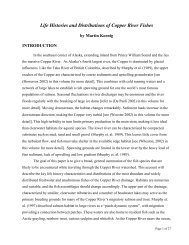Mitigation for the Construction and Operation of Libby Dam
Mitigation for the Construction and Operation of Libby Dam
Mitigation for the Construction and Operation of Libby Dam
Create successful ePaper yourself
Turn your PDF publications into a flip-book with our unique Google optimized e-Paper software.
<strong>Libby</strong> Reservoir Gillnet Monitoring<br />
We documented changes in <strong>the</strong> assemblage <strong>of</strong> fish species sampled in <strong>Libby</strong> Reservoir<br />
since impoundment. Kokanee salmon, Kamloops rainbow trout <strong>and</strong> yellow perch did not occur<br />
in <strong>the</strong> Kootenai River prior to impoundment but are now present. Kokanee were released into<br />
<strong>the</strong> reservoir from <strong>the</strong> Kootenay Trout Hatchery in British Columbia (Huston et al. 1984).<br />
Yellow perch may have dispersed into <strong>the</strong> reservoir from Murphy Lake (Huston et al. 1984).<br />
The British Columbia Ministry <strong>of</strong> Environment (BCMOE) first introduced Kamloops rainbow<br />
trout in 1985. Eastern brook trout are not native to <strong>the</strong> Kootenai Drainage, but were present in<br />
<strong>the</strong> river be<strong>for</strong>e impoundment <strong>and</strong> continue to be rarely captured in gillnets within <strong>the</strong> reservoir.<br />
Peamouth <strong>and</strong> nor<strong>the</strong>rn pikeminnow were rare in <strong>the</strong> Kootenai River be<strong>for</strong>e impoundment, but<br />
have increased in abundance in <strong>the</strong> reservoir. Mountain whitefish, rainbow trout, westslope<br />
cutthroat trout <strong>and</strong> redside shiner were common in <strong>the</strong> Kootenai River be<strong>for</strong>e impoundment,<br />
but have decreased in abundance since impoundment.<br />
Kokanee<br />
Since <strong>the</strong> accidental introduction <strong>of</strong> 250,000 fry from <strong>the</strong> Kootenay Trout Hatchery in<br />
British Columbia into <strong>Libby</strong> Reservoir in 1980, kokanee have become <strong>the</strong> second most<br />
abundant fish captured during fall gillnetting. Fluctuations in catch have corresponded to <strong>the</strong><br />
strength <strong>of</strong> various year classes (H<strong>of</strong>fman et al. 2002), <strong>and</strong> have varied by year, with no<br />
apparent continuous trend in abundance (Figure 32). However, kokanee catch in <strong>the</strong> fall net<br />
series follows a general trend <strong>of</strong> decreasing abundance from 1988-1995 <strong>and</strong> an increasing<br />
trend in abundance from 1996-2003 (Figure 32). Average length <strong>of</strong> kokanee has varied<br />
among years. Average length <strong>and</strong> weight between 1988 <strong>and</strong> 2003 was 290.3 mm <strong>and</strong> 235.2 g<br />
respectively (Table 6), while maximum average size occurred in 1992 (350 mm, 411 g).<br />
However, <strong>the</strong> minimum mean length was observed in 2002 (Table 6).<br />
Catch per Net<br />
30<br />
25<br />
20<br />
15<br />
10<br />
5<br />
Spring<br />
r 2 = 0.008<br />
p = 0.739<br />
Fall (1988-1995)<br />
r 2 = 0.44;p = 0.073<br />
Y = 3773 - 1.89*X<br />
Fall (1996-2003)<br />
r 2 = 0.44;p = 0.072<br />
Y = -3964 + 1.99*X<br />
0<br />
1984<br />
1986<br />
1988<br />
1990<br />
1992<br />
1994<br />
1996<br />
1998<br />
2000<br />
2002<br />
Year<br />
Fall Floating Nets<br />
Spring Sinking Nets<br />
Figure 32. Average catch per net <strong>of</strong> kokanee <strong>for</strong> fall floating (1988-2003) <strong>and</strong> spring sinking<br />
(1984-2003) gill nets in <strong>Libby</strong> Reservoir.<br />
91
















